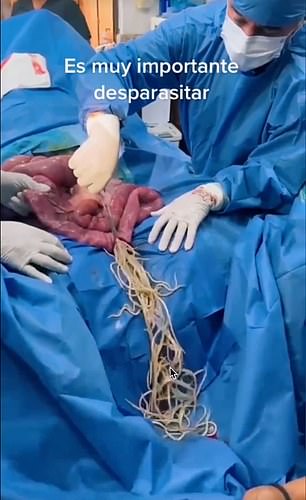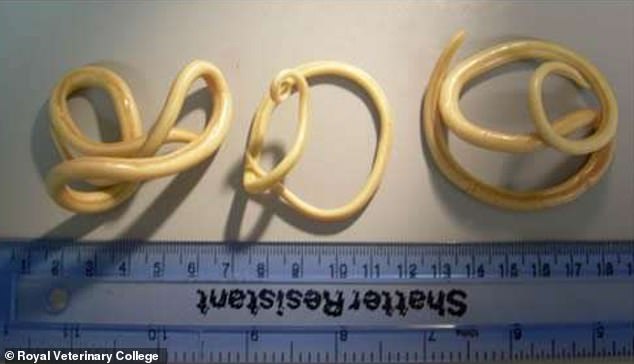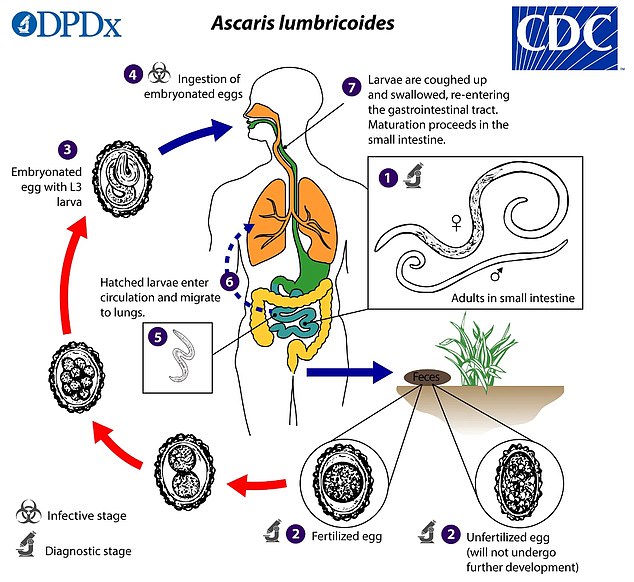Chilling footage shows what happens when giant parasitic WORMS enter the gut – and 4million Americans could suffer unknowingly
An emergency room doctor has shared a shocking video to warn Americans about a parasitic infection that affects as many as 4 million Americans.
The clip, posted by Florida-based physician Dr. Sam Ghali, shows a disgusting bundle of worms writhing out of an intensive care unit onto an operating table.
He explained that the parasites are giant roundworms – or Ascaris lumbricoides – that can grow up to 28 centimetres long and can live in the intestines of humans or animals for up to two years.
The worms, which can be contracted through contaminated food and water, generally do not cause symptoms. However, a large number can cause gastrointestinal problems, such as abdominal pain, diarrhea, and nausea.

Above are two screenshots from the video, which was claimed to show a horse with an intestinal obstruction having its intestines cut open before the worms are removed.
Dr. Ghali explains that the video, which has been viewed half a million times on X, actually shows the intestines of a horse. However, he says the worms can also infect humans.
Dr. Ghali explains that, just like in humans, a buildup of worms can cause a potentially fatal intestinal blockage.
However, veterinarians responding to the video said that a human would not normally develop such a serious infection.
It is estimated that approximately one billion people worldwide are affected by giant roundworms, or one in eight, including 4 million in the US, or one in every 100 people.
People become infected unknowingly by consuming contaminated food or water that contains microscopic eggs of the worm.
This can happen through contamination of hands by pet feces, with the eggs then being passed on to food while a meal is being prepared. Water can become contaminated if poor hygiene results in it being mixed with feces.

Giant roundworms can grow up to 11 inches long and live in the intestines for one to two years. They only cause symptoms if a person has a large infestation

The above chart from the CDC shows the life cycle of the giant roundworm
Dr Ghali said: ‘Although these pests are not known to actually cause intestinal obstruction in humans, they will obviously cause gastrointestinal symptoms. [gastro-intestinal] symptoms.
This species is endemic to areas such as Mexico and South America, Africa and India.
“Even if you don’t live there, this is definitely something you should know if you’re planning on traveling to any of those parts of the world.”
In the US, infections can occur in rural areas or areas with poor sanitation.
Previously, they have also been associated with close contact with pig farms, where the worms may be present.
It is not clear when or where the video was filmed, but it was likely shot in a Spanish-speaking country.
Reacting to the clip, one viewer wrote: ‘so gross! But important to know’, while a second said: ‘about to cancel my trip to Brazil’.
Worm infections are generally diagnosed by looking for traces of microscopic eggs or worms in the feces.
Doctors may also perform a colonoscopy, which involves inserting a camera into the intestines to check for the presence of worms.
The infection is treated with antiparasitic drugs that kill the worms.
The CDC reports online: “This infection is generally rare or nonexistent in developed countries, but sporadic cases may occur in rural, impoverished regions of those countries.”
When a person eats roundworm eggs, they hatch in the intestines, and the larvae then enter the bloodstream and lungs.
They grow in these organs and are then coughed up and swallowed. The worms can then return to the intestines, where they remain for a year or two.
